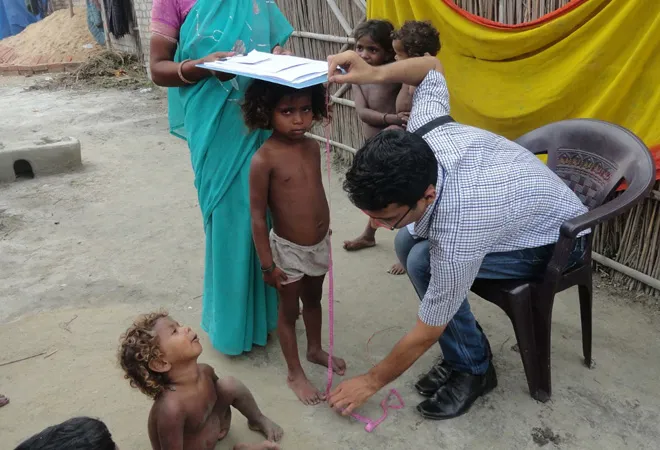-
CENTRES
Progammes & Centres
Location
The killer outbreak of encephalitis has exposed the widened fault lines in India’s most backward state.

During the course of the last week, a terrible and enormous human tragedy that unfolded in this country went unheeded and unnoticed in the heat of the countrywide doctors’ strike, triggered by an assault on two junior doctors at NRS Hospital in Kolkata. It took this event to subside and disappear from the headlines before the country noticed that, in the interim, more than a hundred children had lost their fight with Acute Encephalitis Syndrome (AES) in Bihar’s Muzaffarpur district. The children mostly belonged to the age group between one and ten. What they shared, apart from age, was abject poverty that did not even permit grief. Raj Kishore Ram, on losing his four-year old son to encephalitis, had no time to weep. His priority, as a daily wage labourer, was to find work, so that his wife and three more children could live. This situation repeated itself in one after another poor family that had children felled by AES.
Although Muzaffarpur is in a remote part of the state, it is not inaccessible. The district headquarters is a mere 72 kms. away from the state capital Patna and can be reached by road in less than two hours. However, the casualness with which the state authorities approached the matter forced a conscientious petitioner to escalate the matter up to the Supreme Court seeking a direction to the Centre to immediately constitute a team of medical experts to go into the causes of the disease — the AES — and for providing all necessary medical equipment and support for the effective treatment of children.
What saddens Indians is that these deaths were not a sudden 2019 occurrence. Deaths on account of AES have taken place since 2008 in the state and particularly since 2014 — the year that witnessed 139 deaths — and now total around a thousand over a decade. Several attempts at pinpointing the cause of the disease have been made but no agreed diagnosis has been established. Some experts suspect that this might be caused by a toxin identified as methylene cyclopropyl glycine found to be present in ‘litchi’ seeds. Other studies discount this as no such toxin was found present in the fruit pulp, root, seeds or skins. Some investigations also linked the heat wave and scrub typhus to AES. Many more such theories abound but nothing conclusive has emerged.
However, what is not denied is that malnutrition makes the children particularly vulnerable to the disease. Health surveys clearly reveal that in Bihar, a very high number of children do suffer from malnutrition. In 2015-16, National Family Health Survey-4 revealed that 48% of children aged less than five were stunted and this was the highest in India. However, state authorities have sought to underplay the issue of malnutrition. Any such attempt smacks of insensitivity and a clear denial of governmental accountability. It is for this reason that the National Human Rights Commission (NHRC) has been driven to send notices to the Ministry of Health and Government of Bihar over the continued deaths of children in Muzaffarpur. It has also sought a report on “not only vaccination, but all precautionary measures such as cleanliness and hygiene.” The NHRC was categorical in stating that the state appeared “to have failed to protect the young innocent lives.”
While debate rages on the cause of the disease and acts of omission and commission by Governments of India and Bihar, it is necessary to look at the significance attached over several decades to the matter of national health. Healthcare in India has been a low priority item despite the universal acknowledgment that it is one of the two most significant social infrastructures in any country. Health budgets in a nation as huge as India and with poor health indicators have been abysmally small. Bihar, as one of the least developed states, quite naturally, has one of the poorest health infrastructures, and the state is very weak even in primary health care. This feeds into its poverty and socio-economic backwardness.
It is important to highlight the state of healthcare system in the state. Bihar is said to be short of several thousand doctors. All 130 primary health centres of Muzaffarpur district were given a rating of 0 out of 5 in 2018-19 by an official agency of the Ministry of Health. Ninety-eight PHCs did not meet the minimum requirement of having one medical officer, two nurse-midwives and a labour room. A central team deputed to Muzaffarpur to investigate AES deaths found the paediatric intensive care unit (ICU) of Sri Krishna Medical College and Hospital woefully short of the minimum qualification criteria. Neither is there any perceivable accountability for performance in the state’s health care apparatus.
Bihar’s several other indicators are equally poor. It has the lowest per capita income and the least literacy rate among states. It has the highest population density and the lowest level of urbanisation among major states. It also ranks lowest in terms human development index among all states and territories.
It is evident that a state with a huge population cannot be allowed to pull the country backwards. To this end, more energy and investment need to be made nationally in the state and an all-out effort ought to be undertaken in delivering better governance to its people. The Prime Minister has declared that the country has only two castes — the poor and those working to eliminate poverty. The test of the statement would lie in what the Government of India achieves in Bihar whose people do not seem to be sharing the fruits of development. Sadly, the socio-economic indicators of the developed parts of the country and Bihar are widening and no visible impactful attempt to reverse this seems to be anywhere in sight.
This is borne out by the commitments made and not delivered since 2014. During that year, GoI had announced the establishment of a new AIIMS (All India Institute of Medical Sciences) in Bihar. It also announced that ‘virological diagnostic laboratories’ would be set up at Gaya, Bhagalpur, Bettiah, Pavapuri and Nalanda and multi-disciplinary research units at Muzaffarpur and Darbhanga. Besides, an INR 100 crore, 100-bedded hospital would be built in the state and there shall be 100% immunisation of children against AES. After a passage of five years, all of the above fall in the category of unfulfilled promises.
The cleanliness surveys undertaken under the Clean India Campaign have listed several settlements in Bihar as the least hygienic in the country. Follow-up surveys have not improved their rankings. This highlights that it does not help a seriously ill patient to be told by the doctor that he is more ill than the others and that he should do better. It is the doctor’s responsibility to diagnose his problem and cure him.
Bihar will not come out of its terminal crisis unless the Government of India puts its heart into the job. The task is much too large to be handled by the state alone, given its proven ineptness. GoI needs to set up a high-level task force to develop a strategy for the state, equip it with a committed and dedicated team for implementation, provide the team with adequate resources and set targets of development indices to be achieved in the next five and ten years that bring the state and its people on par with the rest of the country. Without such an effort, the state will continue to pull back the nation’s development and impact its standing as a developed nation. The abandoned state must be reclaimed and revived.
The views expressed above belong to the author(s). ORF research and analyses now available on Telegram! Click here to access our curated content — blogs, longforms and interviews.

Dr. Ramanath Jha is Distinguished Fellow at Observer Research Foundation, Mumbai. He works on urbanisation — urban sustainability, urban governance and urban planning. Dr. Jha belongs ...
Read More +